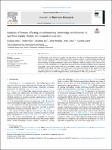Analysis of factors affecting cross-boundary knowledge mobilization in agri-food supply chains: An integrated approach
| dc.contributor.author | Zhao, G | |
| dc.contributor.author | Chen, H | |
| dc.contributor.author | Liu, Shaofeng | |
| dc.contributor.author | Dennehy, D | |
| dc.contributor.author | Jones, P | |
| dc.contributor.author | Lopez, C | |
| dc.date.accessioned | 2023-07-11T13:17:51Z | |
| dc.date.available | 2023-07-11T13:17:51Z | |
| dc.date.issued | 2023-09 | |
| dc.identifier.issn | 0148-2963 | |
| dc.identifier.issn | 1873-7978 | |
| dc.identifier.other | 114006 | |
| dc.identifier.uri | https://pearl.plymouth.ac.uk/handle/10026.1/21040 | |
| dc.description.abstract |
Agri-food supply chains (AFSCs) link produce from farm-to-fork. Over 80% of businesses operating in AFSCs are small and medium-sized enterprises (SMEs) that lack the necessary resources to make knowledge accessible and usable to other stakeholders. To enhance AFSCs’ performance, we adopt an integrated approach to analyze factors affecting knowledge mobilization (KMob) across boundaries. Thematic analysis of data collected from interviews reveals 11 KMob factors. We apply total interpretive structural modeling (TISM) to identify influential relationships among these factors, and fuzzy cross-impact matrix multiplication applied to classification (MICMAC) to distinguish each factor’s role in the system. Our results complement previous studies in showing that power and national culture are critical KMob factors with the greatest ability to elicit other factors. Our study has implications for SME management teams, focal companies of AFSCs and governments. | |
| dc.format.extent | 114006-114006 | |
| dc.language | en | |
| dc.publisher | Elsevier BV | |
| dc.subject | Knowledge mobilization | |
| dc.subject | Boundary-crossing mechanisms | |
| dc.subject | Knowledge boundaries | |
| dc.subject | Total interpretive structural modeling | |
| dc.subject | Fuzzy MICMAC analysis | |
| dc.subject | Agri-food supply chains | |
| dc.title | Analysis of factors affecting cross-boundary knowledge mobilization in agri-food supply chains: An integrated approach | |
| dc.type | journal-article | |
| dc.type | Journal Article | |
| plymouth.author-url | https://www.webofscience.com/api/gateway?GWVersion=2&SrcApp=PARTNER_APP&SrcAuth=LinksAMR&KeyUT=WOS:001004817300001&DestLinkType=FullRecord&DestApp=ALL_WOS&UsrCustomerID=11bb513d99f797142bcfeffcc58ea008 | |
| plymouth.volume | 164 | |
| plymouth.publication-status | Published | |
| plymouth.journal | Journal of Business Research | |
| dc.identifier.doi | 10.1016/j.jbusres.2023.114006 | |
| plymouth.organisational-group | |Plymouth | |
| plymouth.organisational-group | |Plymouth|Faculty of Arts, Humanities and Business | |
| plymouth.organisational-group | |Plymouth|Users by role | |
| plymouth.organisational-group | |Plymouth|Users by role|Academics | |
| plymouth.organisational-group | |Plymouth|Faculty of Arts, Humanities and Business|Plymouth Business School | |
| dcterms.dateAccepted | 2023-04-25 | |
| dc.date.updated | 2023-07-11T13:17:50Z | |
| dc.rights.embargodate | 2023-7-13 | |
| dc.identifier.eissn | 1873-7978 | |
| dc.rights.embargoperiod | forever | |
| rioxxterms.versionofrecord | 10.1016/j.jbusres.2023.114006 |


